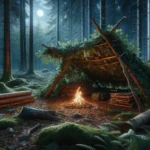Imagine losing your way under a vast night sky — it’s a camper’s challenge that can turn into an adventure. Star navigation is not just for sailors; it’s equally valuable for those who enjoy the wilderness.
Our guide will illuminate how the constellations above can act as your map and compass in times of need. Let’s reach for the stars and find our way!
Table of Contents
Key Takeaways
- Navigating by the stars is a reliable method that doesn’t depend on technology and offers campers an ancient way to find their direction in the wild. By learning to identify key constellations like Ursa Major, Ursa Minor, Cassiopeia, Orion, Virgo, and Centaurus, outdoors enthusiasts can use them as guides for orientation.
- Essential tools such as sextants and chronometers enhance astronavigation by allowing precise measurements of angles between stars and the horizon, as well as keeping accurate time to determine longitude.
- Basic techniques in star navigation include using shadows at sunrise or sunset to establish east-west bearings and observing Polaris’s elevation above the horizon for latitude. These natural cues are invaluable when modern devices fail.
- Knowing how to locate cardinal directions using celestial bodies—like finding north with Polaris (the North Star) or south by observing the Moon’s path—is crucial when exploring off-grid territories.
- Practicing these astronavigation skills regularly under different conditions will improve accuracy. Every observation made during clear nights refines your ability to navigate confidently through nature without relying solely on electronic devices.
Having the skills to navigate by stars is invaluable for campers venturing into secluded wilderness areas. Modern devices like GPS can fail due to weak signals or dead batteries, leaving you without a way out of an unfamiliar forest or mountain range.
Star navigation emerges as a reliable ancient guide that works without fail and requires no power source other than your knowledge and the night sky.
Mastering this art connects campers with natural cycles and enhances survival skills. Observing celestial bodies such as Polaris and the constellations of Ursa Major and Ursa Minor not only directs you toward true north but also deepens your appreciation for nature’s grand design.
Whether tracing the arc of stars or using the moon’s position to identify cardinal directions, astronavigation empowers explorers with confidence under the open skies.
Embarking on an adventure under the stars transforms when you possess knowledge of celestial navigation. It’s a skill that enables campers to traverse the wild with confidence, using natural cues from the skies to guide their journey—let’s explore these timeless techniques that connect us with ancient explorers.
Bearings of Sunrise & Sunset
Understanding the bearings of sunrise and sunset is a crucial skill for any camper looking to navigate by stars. These daily events are consistent, reliable markers for direction.
- Observe sunrise closely; it always happens in the east. This moment provides a clear orientation point for the eastern direction.
- Pay attention to where the sun sets; it’s your indicator of the west. After sunset, align yourself with this point for an accurate sense of western bearing.
- Use shadows cast by the sun to find north-south lines. An upright stick in the ground will cast a shadow that moves from west to east throughout the day.
- Take note of daylight length as seasons change. Around equinoxes, day length nears equality, offering extra clues about cardinal points at sunrise and sunset.
- Remember that during summer, in the northern hemisphere, sunrise occurs more northeast and sunset northwest; winter flips this pattern southward.
- Your location matters: closer to the poles means more significant variation in sunrise and sunset positions throughout the year than near the equator.
- Track these changes systematically over time. Regular observation can improve your understanding of celestial movements and enhance navigation skills.
- Aligning horizon landmarks with sunrise or sundown positions can assist you in finding your way back if you wander off course during daytime hikes.
Finding North-South From Shadows
Getting your bearings during a camping trip can be as simple as using shadows. Shadows provide a reliable method to find north and south without any complex equipment. Here’s how you can navigate using this time-tested technique:
- Stick Method: Plant a straight stick vertically into the ground on a sunny day. Make sure it’s secure and casts a clear shadow.
- Mark the Tip: Use a stone or any small object to mark the tip of the first shadow in the morning.
- Track Movement: As the sun moves across the sky, the shadow will shorten and then lengthen again. Mark the tip of the shadow a second time in mid-afternoon.
- Draw a Line: Connect your two marks with a straight line; this will give you an east-west direction.
- Stand on the Line: With your left foot at the first mark (morning shadow) and your right foot at the second mark (afternoon shadow), you’ll be facing north if you are in the northern hemisphere.
- Confirm at Night: To check your accuracy, locate Polaris – the North Star – after sundown. It should align well with your earlier determination of north.
The night sky serves as a celestial map, offering campers invaluable guidance through its array of notable stars and constellations. Mastering their patterns unlocks the ancient art of navigation, connecting us with natural waypoints that have led explorers safely across unknown terrains for centuries.
Polaris: The North Star
Polaris holds a unique position in the sky, sitting almost directly above the North Pole. This makes it an excellent fixed point for finding your way when you’re lost in the wilderness at night.
By locating this star, which is the brightest one in the Ursa Minor constellation, also known as the Little Dipper, adventurers can determine north and set their direction accordingly.
Campers find Polaris by first spotting the Big Dipper asterism and imagining a line between its two outer stars. Extend that imaginary line outward, about five times the distance of those pointer stars, and there gleams Polaris.
It’s not just a beacon for orientation; it’s also steeped in history as sailors have relied on this celestial guide for navigation long before compasses were common. Use Polaris to align with true north and gain confidence as you trek through nature under a canopy of stars.
Ursa Major
Just as Polaris serves as a steadfast beacon in the night sky, Ursa Major offers its own array of navigational aids. This constellation, also known as the Great Bear, boasts the well-known Big Dipper asterism within its larger pattern.
Campers can easily spot this group of bright stars due to its distinctive shape and use it as a celestial guidepost. Throughout the year, Ursa Major hangs in the northern hemisphere’s sky, making it an invaluable reference point for those looking to find their way in the wilderness.
To pinpoint Polaris from Ursa Major, simply extend an imaginary line through the ‘pointer’ stars at the edge of the Big Dipper’s bowl. These two stars reliably direct adventurers toward Polaris and true north.
Additionally, because Ursa Major is circumpolar and never dips below the horizon for observers in northern latitudes, campers can rely on this constellation to orient themselves during any season or time of night—a crucial advantage when navigating under starlight.
Ursa Minor
Ursa Minor, often known as the Little Dipper, holds a special place in celestial navigation due to its direct connection with Polaris, our North Star. This constellation serves as a reliable guide because Polaris sits nearly above Earth’s north celestial pole.
For centuries, navigators and explorers have used Ursa Minor’s pattern of stars to locate this constant point in the night sky.
Campers can easily spot Ursa Minor by identifying its seven bright stars which form a simple ladle or dipper shape. The two outermost stars are sometimes called “the Guardians of the Pole” as they conveniently point towards Polaris.
Whether in the vastness of wilderness or amidst the mountains’ majesty, finding Ursa Minor becomes an essential skill for any adventurer seeking direction under the blanket of night.
Cassiopeia
Cassiopeia shines as a beacon in the celestial equator and offers campers more than just a striking view; it’s a key tool for finding your way. Picture its distinctive “M” shape like an arrowhead pointing downwards—this imaginary line leads you straight to Polaris, the North Star, which is crucial for orientation in the northern hemisphere.
Understanding Cassiopeia’s place among the circumpolar constellations helps adventurers discern their east-west bearings as well.
Mastering this constellation’s patterns not only sharpens your astronavigation skills but also elevates your outdoor experience. Grasping its movement through the night sky equips you with reliable clues to steer by, invaluable whether you’re having fun under the stars or navigating through an unplanned emergency situation.
From here, our gaze turns toward another cosmic guidepost: Orion.
Orion
After exploring the “W” of Cassiopeia, turn your gaze to Orion, another beacon of the night sky. Known as The Hunter, this constellation is not just striking but extremely useful for navigation after dark.
Look for Orion’s Belt, a line of three bright stars that form part of the hunter’s iconic outline. These stars are a reliable guide and can help determine east or west because Mintaka, the star on the belt’s northern end, almost perfectly aligns with the celestial equator.
Venture into using Orion in your astronavigation by locating its famous belt first. This trio points southeast in Northern Hemisphere evenings during fall and winter months and southwest in late spring.
They also lead you directly to Sirius – the brightest star we see from Earth – if followed along their alignment towards the horizon. For those under southern skies, tracking down Orion can assist in identifying other important constellations such as Canis Major and Taurus, which hover nearby – each an anchor point helping you chart a path through wilderness treks or backcountry camping trips under a vast celestial canopy.
Virgo
Look up on a clear night, and you might spot Virgo, one of the largest constellations in the sky. Known for its bright star, Spica, Virgo is not just a beautiful sight; it’s also an invaluable tool for celestial navigation.
Imagine you’re lost amidst nature’s vastness – finding Spica could help orient you to the celestial equator.
Tracking down Zeta Virginis within Virgo brings another level of guidance as this star marks the celestial equator directly. With these stars as your guideposts, determining east and west becomes simpler under the expansive night sky.
For campers and adventurers alike, mastering the constellation Virgo can add another layer of orientation knowledge while enjoying the great outdoors.
Centaurus
Centaurus is your guiding light in the southern sky, acting as a beacon for celestial navigators below the equator. With stars that shine bright enough to catch your eye on a clear night, this constellation can help orient you when lost in the wilderness.
It stands out because it’s home to Alpha Centauri, one of the closest star systems to Earth and a key landmark for anyone trying to find their way by stargazing.
Use Centaurus as a milestone along with its neighbor, the Crux constellation, also known as the Southern Cross. The two constellations together form an unmistakable pattern that can lead you toward the south celestial pole.
Mastering their positions means gaining confidence while navigating vast open spaces under southern hemisphere skies. Moving forward, let’s explore how navigation tools like sextants and chronometers can further enhance your astronavigation skills.
Whether seasoned campers or new adventurers, explorers of the night sky will find that mastering a few essential instruments can unlock the art of astronavigation. Let’s delve into the quintessential tools that have guided voyagers across oceans and through wildernesses by the celestial canopy above.
Sextant
A sextant is your go-to gadget for precise celestial navigation, offering a way to measure the angles between a star or planet and the horizon. Picture yourself aligning the sun’s image with the sea line through this tool’s telescope; that’s how navigators pin down their location on Earth’s vast canvas.
Mastering a sextant guides you through open waters and deepens your connection to traditional seafaring methods.
Hikers and outdoor aficionados can rely on this historic instrument as an empowering backup to modern tech like GPS devices. Knowing how to use a sextant instills confidence during backcountry explorations, ensuring you can find your bearings when digital gadgets fail or are unavailable.
It keeps alive an age-old skill that challenges you to engage directly with nature’s celestial cues, sharpening essential survival skills out in the wild.
Chronometer
While a sextant can help you measure the angle between celestial objects and the horizon, it is a chronometer that keeps precise time, an essential element in finding your longitudinal position.
Chronometers are highly accurate timepieces designed to resist changes in temperature and pressure, which could affect their accuracy. Mariners have relied on them since John Harrison invented the marine chronometer in the 18th century, revolutionizing long-distance sea travel.
These precision instruments allow campers and navigators to compare the time of a celestial event, such as solar noon or moon’s transit at its highest point with Greenwich Mean Time (GMT).
The difference reveals how far east or west one is from the prime meridian. Before setting off into the wilderness or open seas, ensuring your chronometer is set accurately to GMT will give you confidence in your ability to pinpoint longitude by observing heavenly bodies like Orion’s belt or Sigma Octantis while aligning it with Earth’s rotation speed.
Almanac
An almanac is an essential tool for anyone keen on mastering astronavigation. This handy book is packed with crucial information about celestial events, weather patterns, sunrise and sunset times, and positions of stars and planets throughout the year.
Campers can use it to foresee night skies, plan their routes according to celestial changes, or even predict the best time for stargazing by looking at lunar cycles.
With an almanac in your backpack, you’ve got a reliable guide to help align your travels with astronomical occurrences. It’s especially useful when trekking into areas where digital signals are weak or non-existent; here, traditional methods like using an almanac become invaluable.
You’ll learn how constellations shift seasonally and how this affects your ability to navigate under the open sky. Whether you’re pinpointing Polaris or tracking Orion across the heavens, referencing an almanac makes finding these key navigational stars simpler.
Mastering the art of astronavigation transforms the night sky into your personal GPS, where celestial bodies guide your path through the wilderness. Immerse yourself in ancient techniques that have steered adventurers for centuries, learning to pinpoint latitude and longitude just by looking up.
Finding Your Latitude
Understanding your latitude is critical while navigating under the starlit sky. It’s a measure of how far north or south you are from the equator.
- Look for Polaris, commonly known as the North Star, which sits almost directly over the North Pole. Its elevation above the horizon closely matches your latitude in the Northern Hemisphere.
- Use constellations to find Polaris if it’s not immediately visible. The Big Dipper, part of Ursa Major constellation, points towards Polaris with its ‘pointer stars’.
- Identify Ursa Major and follow an imaginary line from its “pointers,” Merak and Dubhe, to locate the North Star.
- Measure the angle between Polaris and the horizon using a sextant or make a simple angle measuring tool with a protractor and plumb line.
- Record this angle as accurately as possible; precision is key in determining your latitude correctly.
- Cross-reference your measured angle with an almanac that provides declination data to confirm your findings.
- Practice these steps regularly; familiarity increases accuracy in real-world navigation scenarios.
Finding Your Longitude
Determining your longitude while out in the wilderness is an advanced yet rewarding skill. Master this technique, and you’ll precisely pinpoint your location, using the stars above.
- Start by getting familiar with a star chart or celestial navigation tool such as a sextant or quadrant.
- Choose a reference star that’s listed in your almanac; it should be one you can easily identify like Arcturus or Beta Centauri.
- Measure the angle between the horizon and your chosen star at its highest point in the night sky, commonly called its meridian passage.
- Note the exact time of your measurement with a chronometer, which keeps time more accurately than a regular digital watch.
- Consult your almanac to find out what time that particular star is due at its meridian passage at Greenwich, also known as Greenwich Mean Time (GMT).
- Calculate the difference between GMT and the time on your chronometer when you observed the star at its highest point.
- For every hour of difference between these two times, estimate that you’re roughly 15 degrees east or west of Greenwich since Earth rotates about 15 degrees per hour.
- If your observed time is earlier than GMT, you are likely located to the west of Greenwich; if it’s later, then you’re to the east.
- Refine this method by taking multiple observations and preferably using different reference stars throughout the night for improved accuracy.
Locating cardinal directions: north, south, east, and west
Mastering the skill of finding your longitude sets the stage for the next critical step in astronavigation: pinpointing cardinal directions. With celestial cues from the Sun and stars, adventurers can confidently establish their bearings under a starlit sky.
- Use the North Star, Polaris, to find north. This reliable beacon shines directly above the celestial north pole. Spotting Polaris is easy when you locate Ursa Minor, also known as the Little Bear or Little Dipper.
- Track down south by observing the Moon’s path. When a crescent moon or full moon climbs to its highest point in the night sky, it indicates due south.
- Identify east and west with help from rising and setting stars. Stars near the celestial equator, like those in Orion’s belt from the Orion constellation during winter months, ascend due east and descend due west.
- Observe shadows at sunup to determine directions. Marking where shadows fall in the early morning light gives clues for east-west alignment.
- Locate Cassiopeia to assist in finding Polaris if Ursa Major is obstructed or not visible; it forms an arrow that points towards this essential navigator’s star.
- If you’re equipped with a sextant and almanac, use these tools to measure angles between key stars like Gacrux or Arcturus and improve your accuracy in determining cardinal points.
- In Southern Hemisphere excursions, climbers can use Crux or “the Southern Cross” constellation to approximate south by drawing a line through its long axis extending towards the horizon.
Conclusion
Embrace the challenge of astronavigation and make your next camping adventure unforgettable. With stars as your guides, you’ll unlock a timeless skill that connects you to the natural world in profound ways.
Keep practicing, and before long, the night sky will reveal its secrets, transforming how you explore the great outdoors. Remember, every clear night brings another chance to hone your celestial navigation abilities – so look up and stride confidently under the starlit canopy.
Yes, tips for navigating techniques for direction finding without a compass can also apply to astronavigation. Both methods rely on natural cues and landmarks to determine direction and position. By studying the stars and using celestial bodies as reference points, astronavigation can be a reliable alternative to compass navigation in certain situations.
FAQ
Can you really use stars to find your way while camping?
Yes, you can navigate using the stars by identifying constellations like Orion the Hunter and The Plough to locate the Pole Star. This has been a trusted method in mountaineering and exploration for centuries.
How do I find the North Star?
Firstly, spot The Plough constellation; then follow an imaginary line from its edge extending outwards. This line points directly at Polaris, commonly known as the Pole Star or North Star.
The constellation Orion serves as a guidepost in the night sky because of its brightness and ease of identification, which helps campers orient themselves during their nocturnal adventures.
Basic star navigation requires no special gear; however, tools like a micrometer can improve accuracy when measuring angles between stars but are not essential for simple orientation tasks under open skies.







Leave a Reply